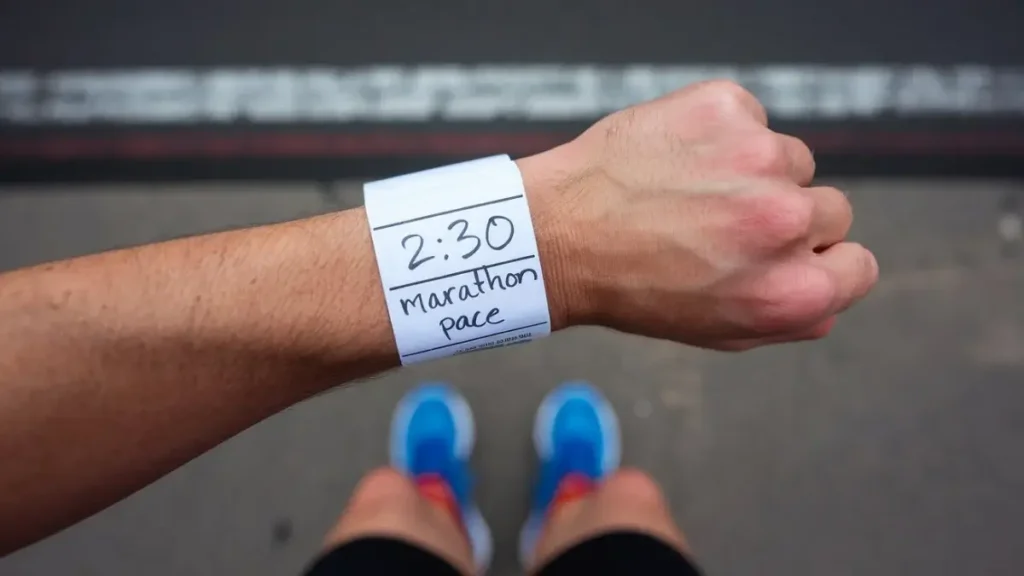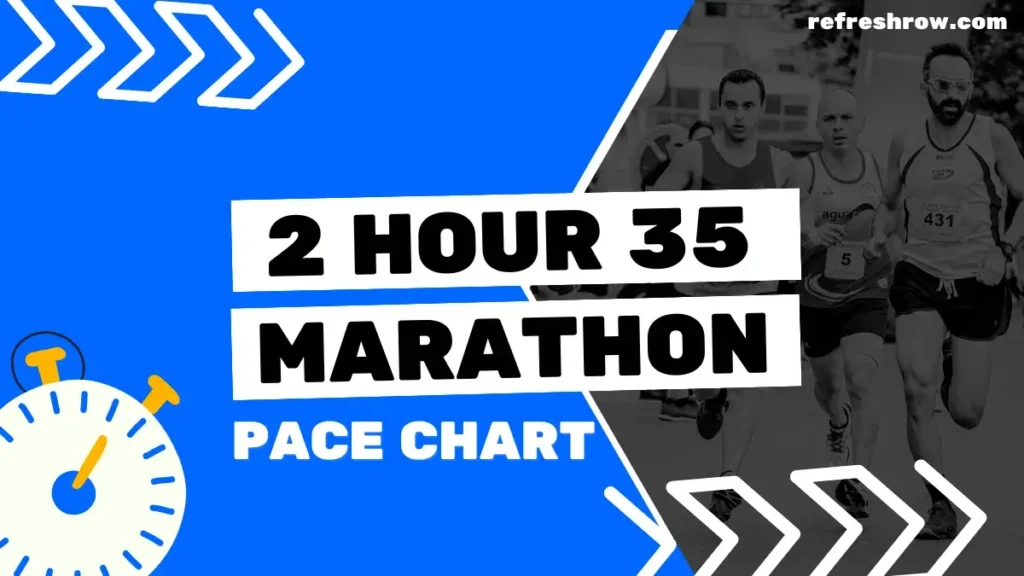To run a 5:15 hour marathon you need to run at a pace of 12:01 per mile or 7:28 per kilometer.
Following the splits below (and shaving off a second), you’ll run a sub 5:15 marathon.
I’d recommend aiming to run 1-2 minutes ahead of the split target time from 10 miles, as you’ll likely come up against crowding on race day.
5:15 Marathon Pace in Miles
| Mile | Split |
|---|---|
| 1 | 12:01 |
| 2 | 24:02 |
| 3 | 36:03 |
| 4 | 48:03 |
| 5 | 1:00:04 |
| 6 | 1:12:05 |
| 7 | 1:24:06 |
| 8 | 1:36:07 |
| 9 | 1:48:08 |
| 10 | 2:00:09 |
| 11 | 2:12:09 |
| 12 | 2:24:10 |
| 13 | 2:36:11 |
| 14 | 2:48:12 |
| 15 | 3:00:13 |
| 16 | 3:12:14 |
| 17 | 3:24:15 |
| 18 | 3:36:15 |
| 19 | 3:48:16 |
| 20 | 4:00:17 |
| 21 | 4:12:18 |
| 22 | 4:24:19 |
| 23 | 4:36:20 |
| 24 | 4:48:21 |
| 25 | 5:00:21 |
| 26 | 5:12:22 |
| 26.2 | 5:15:00 |
Download
5:15 Marathon Pace in KM
| KM | Split |
|---|---|
| 1 | 7:28 |
| 2 | 14:56 |
| 3 | 22:24 |
| 4 | 29:52 |
| 5 | 37:20 |
| 6 | 44:48 |
| 7 | 52:15 |
| 8 | 59:43 |
| 9 | 1:07:11 |
| 10 | 1:14:39 |
| 11 | 1:22:07 |
| 12 | 1:29:35 |
| 13 | 1:37:03 |
| 14 | 1:44:31 |
| 15 | 1:51:59 |
| 16 | 1:59:27 |
| 17 | 2:06:55 |
| 18 | 2:14:23 |
| 19 | 2:21:50 |
| 20 | 2:29:18 |
| 21 | 2:36:46 |
| 22 | 2:44:14 |
| 23 | 2:51:42 |
| 24 | 2:59:10 |
| 25 | 3:06:38 |
| 26 | 3:14:06 |
| 27 | 3:21:34 |
| 28 | 3:29:02 |
| 29 | 3:36:30 |
| 30 | 3:43:58 |
| 31 | 3:51:26 |
| 32 | 3:58:53 |
| 33 | 4:06:21 |
| 34 | 4:13:49 |
| 35 | 4:21:17 |
| 36 | 4:28:45 |
| 37 | 4:36:13 |
| 38 | 4:43:41 |
| 39 | 4:51:09 |
| 40 | 4:58:37 |
| 41 | 5:06:05 |
| 42 | 5:13:33 |
| 42.2 | 5:15:00 |
Download
Other Marathon Pace Charts
Targeting a different time?
Check out the Full Marathon Pace Chart in Miles or KM
Or select a specific finishing time below:
| 3:00 | 4:00 | 5:00 | |
| 3:05 | 4:05 | 5:15 | |
| 3:10 | 4:10 | 5:30 | |
| 3:15 | 4:15 | 5:45 | |
| 3:20 | 4:20 | 6:00 | |
| 3:25 | 4:25 | 6:15 | |
| 2:30 | 3:30 | 4:30 | 6:30 |
| 2:35 | 3:35 | 4:35 | 6:45 |
| 2:40 | 3:40 | 4:40 | 7:00 |
| 2:45 | 3:45 | 4:45 | |
| 2:50 | 3:50 | 4:50 | |
| 2:55 | 3:55 | 4:55 |
Training for a 5:15 Marathon
Is 5:15 a Good Marathon Time?
Well, what do the stats say?
Run Repeat conducted a study that contains 19,614,975 marathon results from more than 32,335 races across the globe, here is how a 5:15 marathon compares against age and gender for the races recorded:
| Overall | You’re faster than 18.3% of all runners. |
| Male | You’re faster than 12.8% of males. |
| Female | You’re faster than 25.7% of females. |
| <20 | You’re faster than 19.0% of under 20s. |
| 20-29 | You’re faster than 12.6% of 20-29 year olds. |
| 30-39 | You’re faster than 12.7% of 30-39 year olds. |
| 40-49 | You’re faster than 15.4% of 40-49 year olds. |
| 50-59 | You’re faster than 24.3% of 50-59 year olds. |
| >60 | You’re faster than 44.8% of over 60s. |
Training Runs and Paces for a 5:15 Marathon
To break a 5:15 marathon you’ll need to do some serious distance in your training, I recommend at least 10 miles (16km) per week.
You’re also going to need to make sure you’ve crossed off these milestones for other race distances:
- A 5k in 32:50
- A 10k in 1:08:20
- A half marathon in 2:23:00
Training Paces
| Pace | Mins per Mile | Mins per KM |
|---|---|---|
| Easy | 13:32 | 8:24 |
| Steady | 12:01 | 7:27 |
| 10k | 11:01 | 6:50 |
| 5k | 10:34 | 6:34 |
| 1 Mile | 9:49 | 6:08 |
Weekly Mileage Targets
| Target Mileage: | Gradually increase your weekly mileage from 12 miles (19 km) to a peak of 18 miles (29 km). |
| Incremental Increase: | Increase mileage by approximately 10% each week, with every fourth week as a recovery week where mileage is reduced by 20-30%. Make sure to taper for the last 1-2 weeks. |
Long Run Structure
| Total Distance: | Build up to long runs of 12-14 miles (19-22 km). |
| Segment Example: | First 5 miles (8 km): Easy pace, heart rate 140-150 bpm (approximately 14:30/mile or 9:01/km). Next 1 mile (1.6 km): Fast pace at 10:10/mile (6:19/km). Next 5 miles (8 km): Medium effort, heart rate around 160 bpm (approximately 11:00/mile or 6:50/km). |
Why This Works: Incorporating varied paces within long runs enhances lactate tolerance, which helps on race day when you’ve got to maintain pace despite feeling fatigued. By practicing surges during a run, you can build up your physical and mental resilience (lots of elite marathon runners use these strategies during their training)
Alternating Long Runs: Alternate between structured long runs (easy/fast segments) and easier long runs. For easier long runs, maintain a steady, comfortable pace throughout, focusing on mileage rather than speed to aid recovery.
Speedwork Sessions
| Short Intervals: | – 400m repeats at 5:00 per interval (6:15/km). – Aim for 6-8 repetitions with equal time for recovery. |
| Mile Repeats: | – 1 mile repeats at 10:10 per mile (6:19/km). – Aim for 4-5 repetitions with a 1-2 minute recovery jog. |
| Longer Intervals: | – 2 mile repeats at 10:20 per mile (6:25/km). – Aim for 3-4 repetitions with a 2-3 minute recovery jog. |
Recovery and Rest Days
| Rest Days: | Incorporate 1-2 rest days per week to allow your body to recover and prevent overtraining. |
| Easy Run Days: | Include 1-2 easy run days per week at a relaxed pace of 15:00/mile (9:19/km), covering 3-4 miles (5-6.5 km) per day. Try to keep your heart rate below 140 bpm on easy days to ensure proper recovery and aerobic development. |
My Tips to Run a Sub 5:15 Marathon
Focus on “Effort-Based” Pacing Rather Than Time Alone
My first top tip is it’s important to pay attention to your effort level, not just the numbers on your watch.
Because conditions like hills, heat, or wind are going to mess with your time, it’s impossible to run exactly at your target pace.
Instead of obsessing over the clock, listen to your body.
If you’re on an uphill, it’s okay to slow down slightly, and if you’re cruising downhill, use that momentum.
The goal is to keep your effort steady, not necessarily your pace.
This will keep your energy levels more balanced across the entire marathon.
Use Pace Zones to Manage Your Effort Throughout the Race
One technique I find really effective is breaking the race into “pace zones.”
For example, miles 1-8 are your warm-up zone – keep things slow and steady at around 12:15-12:20 per mile.
Then, miles 9-18 are your cruising zone, where you try to lock into that 12:00-minute-per-mile pace.
Finally, miles 19-26.2 are your “hold on and finish” zone, where if you’ve conserved energy, you can go slightly faster and hit your target, making sure you finish strong.
This approach helps control your pacing so you don’t burn out early.
Include Race Pace Segments in Your Long Runs
In training, practice adding segments of your race pace into your long runs.
Try running the first say 3-5 miles of a 12-mile run at your 12:00 per mile pace.
Then try doing the same for the middle 3-5 miles (which should be slightly harder as you’re a bit more tired).
Then finally for the last 3-5 miles (this should be harder again).
This teaches your body how to run efficiently at your target pace, even when you’re tired.
It’s a strategy I’ve used during my training, as it helps to make the marathon pace feel natural on race day.
It also boosts your confidence, knowing you’ve hit your goal pace even on fatigued legs.
Use a Pacemaker or Pacing Group to Keep Steady
If you’re the type of runner who struggles with pacing yourself, don’t hesitate to join a pacing group or follow a pacemaker during the race (the guys with the flags on their back).
When you sign up for the marathon, make sure you put your target finish time.
Then on race day, there should be a pacer in your group that you can stick to, which can help to relieve some mental pressure.
This has been a game-changer for me, knowing someone else is managing the pace lets you focus more on your form and breathing.
Plus, there’s camaraderie in pacing groups, and that can help push you through the tougher miles when motivation starts to dip.
I’ll never forget the pony-tailed man I followed round my first marathon!


Row Brown is the founder of Refresh Row. He is a keen marathon runner, his favorite being the London Marathon. He’s now set himself the mission of Running the Entire Length of Spain, which is scheduled for late 2024.


